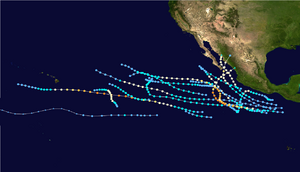1986 Pacific hurricane season
| 1986 Pacific hurricane season |

Season summary map
|
| Seasonal boundaries |
| First system formed |
May 22, 1986 |
| Last system dissipated |
October 25, 1986 |
| Strongest storm |
|
| Name |
Roslyn |
| • Maximum winds |
145 mph (230 km/h) |
| Seasonal statistics |
| Total depressions |
26 |
| Total storms |
17 |
| Hurricanes |
9 |
Major hurricanes
(Cat. 3+) |
3 |
| Total fatalities |
2 |
| Total damage |
$352 million (1986 USD) |
| Related articles |
|
|
Pacific hurricane seasons
1984, 1985, 1986, 1987, 1988
|
| Category 1 hurricane (SSHWS) |
|
|
| Duration |
May 22 – May 29 |
| Peak intensity |
75 mph (120 km/h) (1-min) |
| Tropical depression (SSHWS) |
|
|
| Duration |
May 31 – June 1 |
| Peak intensity |
30 mph (45 km/h) (1-min) |
| Tropical storm (SSHWS) |
|
|
| Duration |
June 17 – June 19 |
| Peak intensity |
40 mph (65 km/h) (1-min) |
| Category 1 hurricane (SSHWS) |
|
|
| Duration |
June 24 – June 30 |
| Peak intensity |
85 mph (140 km/h) (1-min) |
| Tropical storm (SSHWS) |
|
|
| Duration |
July 3 – July 7 |
| Peak intensity |
40 mph (65 km/h) (1-min) |
| Category 4 hurricane (SSHWS) |
|
|
| Duration |
July 16 – July 26 |
| Peak intensity |
130 mph (215 km/h) (1-min) |
| Category 1 hurricane (SSHWS) |
|
|
| Duration |
July 24 – August 3 |
| Peak intensity |
85 mph (140 km/h) (1-min) |
| Tropical storm (SSHWS) |
|
|
| Duration |
August 3 – August 4 |
| Peak intensity |
40 mph (65 km/h) (1-min) |
| Tropical storm (SSHWS) |
|
|
| Duration |
August 16 – August 18 |
| Peak intensity |
40 mph (65 km/h) (1-min) |
The 1986 Pacific hurricane season saw several tropical cyclones contribute to significant flooding to the Central United States. The hurricane season officially started May 15, 1986, in the eastern Pacific, and June 1, 1986 in the central Pacific, and lasted until November 30, 1986 in both regions. These dates conventionally delimit the period of each year when most tropical cyclones form in the northeastern Pacific Ocean. A total of 17 named storms and 9 hurricanes developed during the season; this is slightly above the averages of 15 named storms and 8 hurricanes, respectively. In addition, 25 tropical depressions formed in the eastern Pacific during 1986, which, at the time, was the second most ever recorded; only the 1982 Pacific hurricane season saw a higher total.
Several storms throughout the season affected land. Hurricane Estelle passed south of Hawaii, resulting in $2 million in damage and two deaths.Hurricanes Newton, Paine and Roslyn each struck Northwestern Mexico. While damage was minimal from these three systems near their location of landfall, Paine brought considerable flooding to the Great Plains. The overall flooding event resulted in $350 million in damage, with the worst effects being recorded in Oklahoma. Hurricane Roslyn was the strongest storm of the season, attaining peak winds of 145 mph (230 km/h).
Activity in the Eastern Pacific Hurricane Center's (EPHC) area of responsibility was above average. There were 25 tropical depressions, one short of the record set in 1982, which had 26. Only one storm formed in the Central Pacific Hurricane Center's (CPHC) area of responsibility, Tropical Depression One-C. Six other cyclones entered the CPHC area of responsibility from the EPHC area of responsibility. In all, 17 systems formed, which is two storms above normal. In addition, 9 hurricanes were reported during the season, one more than average. An average number (3) of major hurricanes – Category 3 or higher on the Saffir-Simpson hurricane wind scale – was also reported.
...
Wikipedia


















